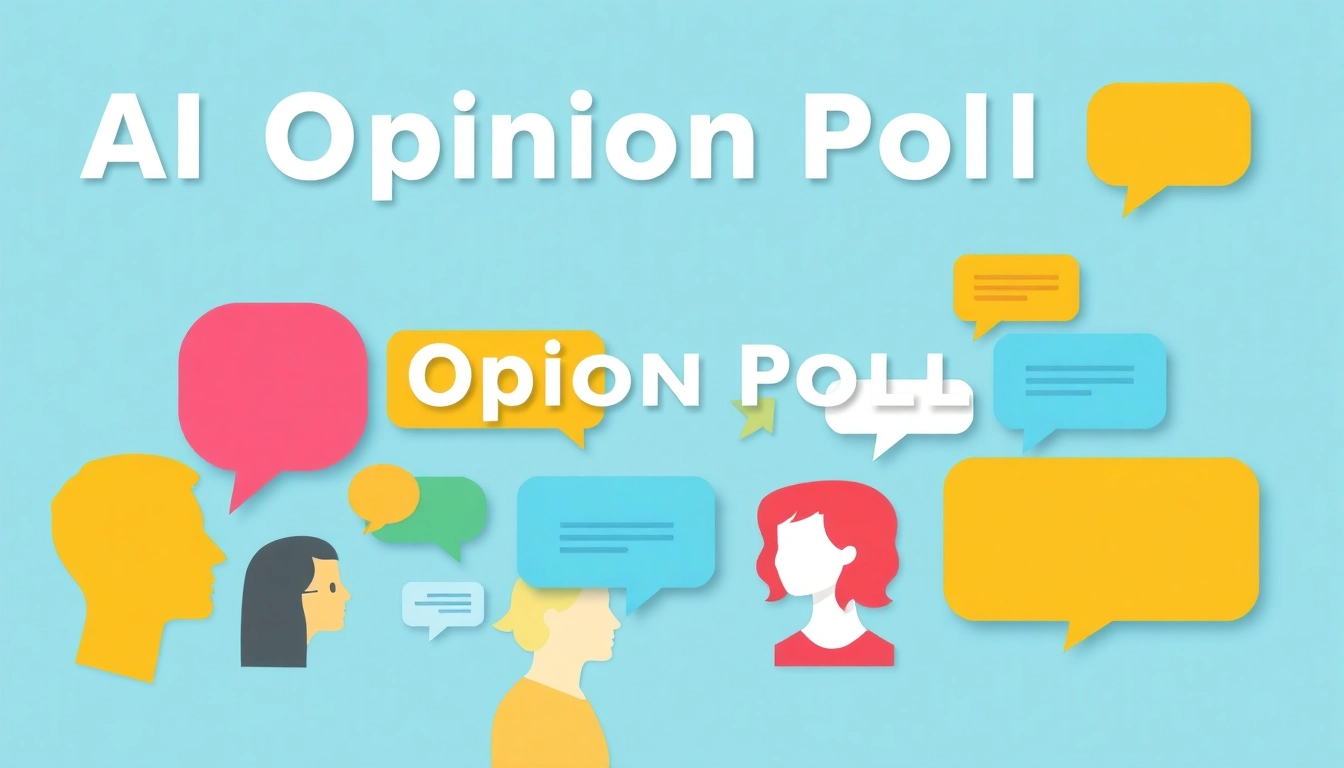The Importance of AI Opinion Polls
In an era defined by rapid technological advancement, understanding public sentiment regarding artificial intelligence (AI) has become critically important. AI opinion polls serve as a tool to gauge perceptions, concerns, and expectations from the public. By delving into the data-driven insights from AI opinion polls, stakeholders in technology, governance, and society can better navigate the complexities of AI integration into daily life. Leveraging an AI Opinion poll can reveal vital information that impacts decision-making across various sectors.
Understanding Public Sentiment
Public sentiment around AI is a multifaceted phenomenon that reflects cultural, economic, and individual perspectives. The perception of AI can range from excitement about its potential benefits to fear of its implications for jobs, privacy, and ethical considerations.
For instance, a recent Pew Research study indicated that 52% of Americans express more concern than excitement regarding AI’s integration into daily life, with only 10% feeling more excited than concerned. This disparity highlights a significant apprehension that informs public opinions on AI policies and implementations.
Impacts on Policy and Development
The implications of these sentiments are profound on several fronts, especially when it comes to policymaking. Policymakers must consider public fears and expectations to create regulations that foster innovation while protecting citizens’ rights and security. As such, AI opinion polls can actively guide the direction of technological development and legislation, ensuring that advancements align with societal values.
Trends in Survey Responses
Analyzing trends in survey responses can illuminate shifts in public attitudes towards AI over time. For instance, gender differences in perception show that women generally exhibit greater skepticism about AI than men. This becomes especially evident in surveys indicating that women express more concern about potential job losses and ethical issues surrounding AI implementation.
Additionally, public opinion may vary significantly based on demographic factors such as age, income level, and educational background, highlighting the importance of diverse sampling in opinion polls.
Key Findings from Recent Surveys
Recent surveys have provided rich data on public perceptions of AI along various parameters. These findings help unpack the nuances of public sentiment and its evolution amid growing technological adoption.
Concern vs. Excitement: A National Overview
The debate over AI often hinges on the dichotomy of concern versus excitement. While many see the potential for innovation, a substantial portion of the population perceives threats, including job losses and misinformation. Notably, 72% of respondents in another survey expressed skepticism about AI’s ability to mitigate the spread of false information, further underscoring collective anxiety regarding AI’s broader implications.
Gender Differences in Perception
Gender differences in perceptions of AI display compelling trends. Research indicates that women are generally more wary of AI than men, showcasing a higher propensity to anticipate negative outcomes from its adoption. Surveys reveal that women are more likely to believe that AI will exacerbate job displacement and compromise privacy. This awareness calls for tailored communication strategies when addressing different demographics to foster a balanced understanding of AI’s risks and benefits.
Impact on Employment and Society
As AI technologies proliferate, concerns about employment and societal impacts intensify. According to a recent poll, a substantial percentage of Americans believe AI ultimately contributes more harm than good when it comes to job security. In the face of these sentiments, organizations must navigate the intricate balance between enhancing productivity through AI and addressing the human consequences of such implementations.
Moreover, understanding these societal impacts is crucial in shaping the ethical guidelines under which AI technologies operate. Ongoing discussions about AI’s role in various sectors—education, healthcare, and manufacturing, among others—must take public sentiment into account to promote a responsible approach to development and application.
Methodology Behind AI Opinion Polls
The credibility and relevance of AI opinion polls stem from their methodological rigor. Understanding these techniques offers insight into how results are derived and can affect interpretations of the findings.
Sampling Techniques and Demographics
Pollsters employ specific sampling techniques to ensure that the population reflects a cross-section of society. Stratified sampling, random sampling, and quota sampling are common methodologies deployed to capture demographic diversity, thus bolstering the reliability of results. Each demographic parameter, including age, gender, income level, and geographic location, must be considered to gain an accurate representation of public sentiment regarding AI.
Data Collection and Analysis
Data collection for opinion polls can occur through various means, including online surveys, telephone interviews, or face-to-face interactions. Each method has its unique advantages and challenges, which can influence response rates and data quality. Once collected, data must undergo a rigorous analysis to identify trends, correlations, and insights. Advanced statistical tools are often employed to ensure a quantitative assessment of qualitative perceptions.
Challenges in Interpretation
Interpreting poll results comes with its set of challenges. Misinterpretations can arise when context is not adequately taken into account. For instance, results may reflect timing biases—the public’s perception may vary significantly based on recent events related to AI. Moreover, the framing of survey questions can lead to different interpretations, making it essential for analysts to ensure clarity and neutrality in wording.
Real-World Applications of AI Poll Results
The insights gleaned from AI opinion polls are invaluable for various stakeholders, including tech developers, policymakers, and advocacy groups. By understanding the public’s perspective, these entities can better align their strategies with societal expectations.
Influencing Tech Development
Tech developers can utilize public opinion data to devise products that cater to consumer concerns and expectations. For example, if surveys reveal a significant worry about privacy issues with AI applications, developers can prioritize transparency and robust data protection measures. This alignment not only enhances user trust but can also improve adoption rates of AI technologies.
Public Awareness Campaigns
Public awareness campaigns can be strategically crafted using insights from AI polls to address prevalent fears and misconceptions about artificial intelligence. By communicating the benefits of AI alongside its risks, organizations can ensure that discussions are balanced and constructive. Such campaigns can also target specific demographics that may exhibit heightened concerns, such as underrepresented communities or older generations.
Guiding Regulatory Decisions
Regulatory bodies can leverage public opinion data to inform guidelines surrounding AI deployment. By understanding where the public draws ethical lines regarding AI usage, policymakers can draft regulations that both encourage innovation and protect societal interests. For instance, if polls indicate widespread concern about AI in decision-making roles, regulators might impose limits on its application in sensitive domains like hiring or criminal justice.
Looking Ahead: Future of AI Opinion Polls
The landscape of AI opinion polling is continually evolving as technology and societal beliefs shift. Looking ahead, several trends are likely to shape the future of these polls, enhancing their relevance and utility.
Technological Advancements in Surveying
As technology evolves, methodologies for conducting polls will likely become increasingly sophisticated. AI itself might be employed to analyze responses and detect sentiment in real-time, enabling instant feedback on public sentiment. Additionally, enhanced data analytics could provide deeper insights, allowing for more granular analysis of public attitudes based on a wider array of variables.
Incorporating Diverse Perspectives
Pursuing inclusion and diversity will become crucial for the authenticity of AI opinion polls. Future surveys must not only incorporate standard demographics but also explore intersectional perspectives that bridge various cultural, racial, and socioeconomic backgrounds. This comprehensive approach will enable a richer understanding of public sentiment and foster inclusive dialogue around AI policy.
Potential for Global Comparisons
As AI permeates global industries, the demand for international comparisons in opinion polls will grow. Insights from different countries regarding AI adoption and sentiment may reveal contrasting cultural approaches to technology, thus enriching the dialogue on best practices. Organizations may be able to share findings and strategies across borders, leveraging successful initiatives to create universally beneficial outcomes.



